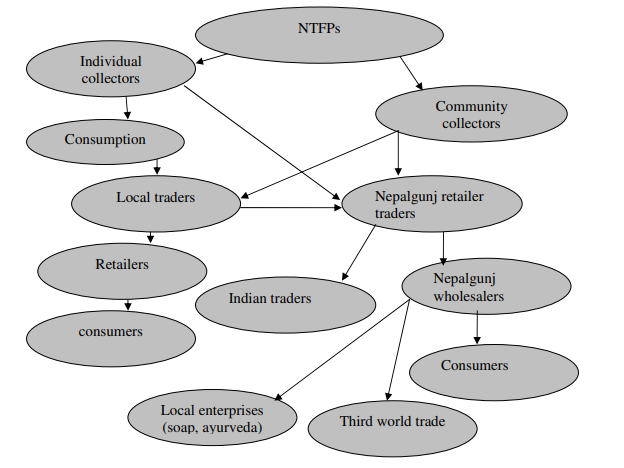TRADE OF MAPS
Trade of medicinal and aromatic plants also creates employment and foreign exchange for developing countries as a significant contribution to the national economy.The potential of MAPs was recognized by the Government of Nepal in the ‘Nepal Trade Integration Strategy’ (MoCS, 2010), which identified medicinal herbs and essential oils as having a medium export potential and a high potential for positive socioeconomic impact.There is a long tradition of trade of MAPs from Nepal to India. Also It is assumed that 80 % of the collected volume goes to India, 10 % to foreign countries other than India and remaining 10 % is used in national herbal preparations.
Export
Nepal’s share in the world market for medicinal herbs is around 0.2 percent (MoCS 2010), and there has been corresponding increase in business volume and value in the country.The government records show that more than 13,000 tons of NTFPs were traded in 2010 (DoF 2011), which was 3,350 tons in 1990 (DoF records).In 2012, the traded volume was about 11,680 tons, which also include large cardamom and essential oils (DoF 2013). The NTFP export from Nepal is increased to NRs 515.4 million (about US $5.9 million) in 2012from NRs 23 million in 1992, which comes to be more than 2100%.Also The contribution of NTFPs to the total export from Nepal has also increased from less than 3% in 2003 to above 9% in 2012.The industry has the potential to grow further, as there is a scope of expanding cultivation and processing of some marketable NTFPs in Nepal.Some prominent examples of successful cultivation in various altitudinal zones during this period include atis, chiraito, satuwa, sugandhawal, alainchi, timur, ritha, rudraksha, tejpat, chamomile, citronella, lemongrass and mentha.Raw products Trade of MAPs in Nepal is on practice from the very early asJaributi. Also Mostly raw materials are export.Thus the production of MAPs is the total quantity collect as wild and exported, purchase and used by the herbal companies inside the country. Also The tentative production data is the quantity license by all 75 District Forest Offices (DFOs) for export as raw or semi-processed.Nepal exports about 55 tons of essential oil, positioning the country 72 in the list of exporters’ category. Similarly, Nepal exports about 29 tons of essential oils to India only . Also MAPs are export to China in high prices.Especially Yarsagumba, Chiraito and Satuwa are in high demand in China increasing.
MARKETING CHANNEL OF NTFP

Fig: Marketing Channel of NTFP
Constraints of marketing of medicinal plants
- Lack of proper market for selling medicinal plants
- Higher benefit of middle man
- Lack of proper infrastructure for marketing of medicinal plants
- Lack of factories and industries related to MAPs.
- Lack of government activities to boost medicinal plant business
- Lack of foreign trade related to medicinal plants
- Lack of infrastructure for post- harvest management
- Lack of rules and regulation for marketing of medicinal plants
Legal Provision regulation the trade and marketing of NTFP
Master Plan for Forestry sector (1988)
The National Conservation Strategy (1988)
Forest Act 1993 and Forest Regulations 1995
Nepal Environmental Policy and Action Plan (NEPAP) 1993 and 1998
Forestry Sector Policy (2000)
Nepal Biodiversity Strategy (2002)
Nepal Biodiversity Action Plan (2002)
Herbs and NTFP Development Policy (2004)
Guidelines for promotion and development of NTFP-based enterprises, 2062 (2005)
Nepal Biodiversity Strategy Implementation Plan (2006)
Role of NTFP and medicinal plants in rural economy
Non-timber forest products (NTFPs) have become increasingly recognized to support resilience and
livelihood enhancement of rural communities in Africa, Asia, and elsewhere in developed as well as
developing countries. A livelihood is sustainable, resources, and activities necessary to provide the
livelihood both material and immaterial social activities and resources.
Traditionally and fundamentally MAPs and NTFPs are correlate with rural peoples’ livelihoods.
NTFPs have the potential to play a vital role in reducing seasonal and long-term malnutrition and food
insecurity.Also Local people have indigenous knowledge of the available forest resources used for their food security in combination with agricultural production. Also Local people sometimes use these sources for income generation, which provides an opportunity for alternative livelihood options as well.
In household economies of rural societies residing in or close the forest, NTFPs have three primary
functions. Initially, NTFPs support the needs of households for their subsistence and consumption for
energy, nutrition, medicine, and construction, etc. Second, in periods of recession (e.g. revenue losses
from certain sources of production, for example, crop failure), they are seen as a defense net and thirdly,
certain NTFPs have daily cash .The importance of NTFPs (utilization and monetary value) may also be
significantly greater than timber production, or land conversion to pastureland or farmland . There is
also growing evidence that local and wider-scale commercialization of NTFPs is increasing in many
regions, providing cash income to numerous households .
It is widely estimated that they draw between 15 and 50% of their household income from the sub-
sector .A proper investment environment can create employment opportunities for local people
reducing the heavy flow of youth migration to cities and foreign countries for jobs. This will also reduce
poverty by providing income raising opportunities locally.
